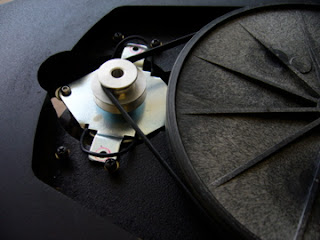A friend of mine has a Thorens TD295 MK III. This turntable has been used for years to play his favourite LPs, but it shows no trace of "aging"; still very fine and elegant it looks. The glossy finish for the upper layer of the plinth is the trick.
The motor speed for this turntable is electronically controlled and end-of-play auto-stop is another add-on feature to this manual turntable.
No mod has been done on this turntable so far and now my friend is looking for some mod to improve its performance. I take a look at it and feel that something needs to be done to the hard-mounted "vibrating" motor which runs "finger-burning" hot after playing just for a while. I suggest he uses my
motor isolation base which serves as both vibration and heat sink.

Since most turntables in the market are using similar AC synchronous motors, these motors fit into my isolation bases well like the Rega motors. But in this case, there is not much free-play in the quite "tight-fitting" motor compartment. So the part where the motor flanges are hard-mounted to, has to be trimmed off slightly. It's a simple job anyway and takes me not more than 10 minutes to cut the screw mounting holes into V-shape grooves (as shown). I am extra careful when trimming so as not to break the "super-short" motor wires (see picture below).
While putting back the motor, I make sure that the motor flanges, motor and motor base are not touching the plinth in the motor compartment. Do you notice there is a small gap at the motor flange?
Put on the rubber belt after aligning the pulley with the sub-platter and my job is almost done!

The motor base now sits under the plinth, "fully isolated". For this TD295 MK III TT, a number of brass spacers are used with the motor isolation base because it has a very much thicker plinth compared to that of Rega TT's. Besides the upper glossy layer (about the thickness of Rega P1 plinth), there is an additional lower layer which consists of four sandwiched layers of MDF board. The rubber feet are also replaced with slightly taller ones to accommodate the height of the motor base.

The modded Thorens TD295 MK III equipped with Ortofon MC15 Super II cartridge is finally ready for testing. Let's see the difference ....
The first thing I notice is that the motor (also the rubber belt) runs much cooler. Earlier I can't even put my finger on the "hot" motor for more than 5 seconds. And I don't feel the motor vibration now when placing my finger on the part of plinth just around the motor. Both the motor and the belt would last longer with this "cooling" effect.
The sonic improvement is substantial with wider and deeper soundstage, clear and distinctive sound of various musical instruments and of course lower noise floor.
It's real joy listening to Nini's Trumpet "IL SILENZIO" in stereo and Acker Bilk's Jazz Band in mono after the motor isolation base mod. For those who are looking for a good preowned turntable, this is another model you can go for. Not forgetting to mention here also other than a well-designed plinth, Thorens TD295 MK III comes with a heavy (~2.4 kg) zinc alloy platter too.

































 Enjoy life with LP's and Turntables designed and coded by EZwpthemes | Bloggerized by FalconHive.
Enjoy life with LP's and Turntables designed and coded by EZwpthemes | Bloggerized by FalconHive.